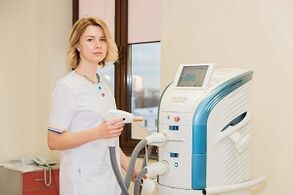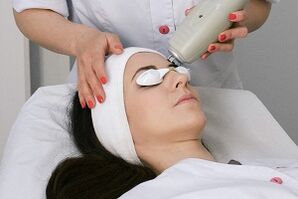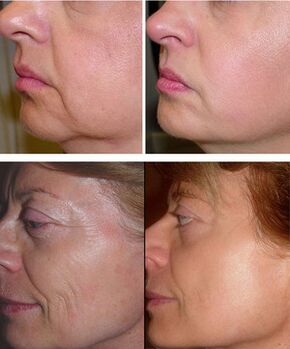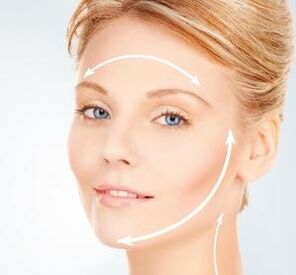
The skin of the face inevitably undergoes a natural aging process, and this can be countered with modern cosmetic and cosmetic procedures.
One of these procedures is facial rejuvenation with laser - the technique triggers rejuvenation and cell repair mechanisms, the facial skin gains a young, fresh and well-groomed appearance.
A special laser is used in cosmetology to eliminate various skin problems. Skin rejuvenation with fractional laser is very popular - it is a cosmetic procedure, after which you can increase skin elasticity, remove fine and deep wrinkles and tighten the oval of the face. After you've completed a sessions course, you'll look a few years younger.
The essence and effect of the technique

Laser rejuvenation of the facial skin is a technique in which laser radiation affects the skin. For this, a laser source - a laser installation - is used an apparatus with which it is possible to adjust the depth of penetration of the laser beam into the skin, the exposure time and the radiation temperature.
The correct selection of procedure parameters is the most important condition for successful rejuvenation, because burns can appear on the face at the slightest mistake of the cosmetologist.
The laser beam penetrating the tissue causes slight damage to the cells in response to the irritation, the cells begin to actively produce collagen and elastin, and the growth of new cells continues.
Stimulation of regeneration processes leads to complete regeneration, rejuvenation of the facial skin. The second name of the procedure is laser peeling.
Indications and contraindications
The technique is used to eliminate such age-related changes in the skin of the face:
- Wrinkles.
- Dark spots.
- Sagging and sagging.
Also indications for the procedure are:
- Facial scars, swelling.
- Acne scars.
- Unwanted tattoos.
- Keratinization of the skin.
- Enlarged pores.
- Vascular network on the face.
- Cracks in the abdomen and legs after pregnancy.
Contraindications to laser peeling are:
- Keloid scars.
- Malignant neoplasms.
- Pregnancy, breastfeeding.
- Herpetic infection during exacerbation.
- Facial wounds and abrasions.
- Any skin disease.
- Fresh tan.
- Moles.
- Taking medication to treat acne.
In most cases, laser rejuvenation takes place without complications, in the first few days after the procedure, the patient notices a slight swelling, redness and peeling of the epidermis. This phenomenon is normal for laser peeling and will go away on its own after a few days.
Possible side effects

However, in some cases, the following side effects may occur:
- Persistent facial redness.
- Exacerbation of acne.
- Increase in skin oily.
- The appearance of hyper or hypopigmentation.
- Herpetic eruptions (if the patient has been previously diagnosed with herpes).
- Burns.
- Maintaining the border between treated and untreated skin areas.
- Subcutaneous bleeding.
The listed side effects disappear for a long time and require additional treatment from a beautician.
Advantages and disadvantages of peeling
Fractional peels are widely used because of the following benefits:
- High efficiency, ability to eliminate significant aesthetic defects.
- Possibility of application on all types of skin.
- Minimum risk of side effects (burns and hyperpigmentation).
- Painlessness.
- Short-term restoration of the skin.
- Ability to treat large areas of skin in one go.
The disadvantage of fractional peeling is its high cost compared to other methods, but considering the effectiveness of the procedure, this disadvantage can be considered insignificant.
Types of laser rejuvenation
There are several types of laser rejuvenation depending on the depth of laser penetration:

- Laser resurfacing. . . The laser "works" on the surface layer of the epidermis by peeling off dead cells. The result of the procedure becomes noticeable after a week: the skin becomes velvety to the touch, fine wrinkles disappear. Three types of laser beams are used during the procedure: erbium, carbon or neodymium.
- Laser biorevitalization. . . As radiation penetrates the deep layers of the skin, some cells are destroyed. The technique is harsher than laser skin resurfacing, but provides a strong anti-aging effect. To increase the effect of the laser, the cosmetologist applies a nutrient mixture to the skin. After the procedure, deep wrinkles disappear and the face contour improves. Recovery after biorevitalization takes place within three months, during this period, edema and severe peeling of the epidermis may continue.
- Fractional peeling. . . Fractional laser rejuvenation is the most effective and at the same time gentle method. The peculiarity of the process lies in the fact that the laser beam is split into many micro rays, due to a softer effect on the skin. The radiation hits the skin in the form of a network, therefore, solid areas remain between the foci of cellular damage - this contributes to faster tissue regeneration and a stronger rejuvenating effect. During fractional stripping, the power of the beam can be varied using a carbon dioxide or erbium laser.
Stages of the procedure
Before carrying out the procedure, you must attend an appointment with a beautician. The doctor identifies the current problems, asks the patient if there are any contraindications to the procedure, and explains how laser rejuvenation will take place.
If the patient's skin is prone to increased pigmentation, a whitening cream is prescribed for a few days before the rejuvenation session. The patient should be aware that sports, heavy physical work, or drinking alcoholic beverages should be avoided before the procedure.
Sequence of performing fractional peeling:
- The face is cleansed using traditional cosmetics.
- Anesthetic cream is applied to the skin.
- After a few minutes, the anesthetic is washed off, a gel is applied to facilitate slipping of the nozzle of the fractional apparatus. Glasses are attached to the eyes of the patient.
- The doctor moves the breast over the face and alternately affects each area with a laser.
- The treatment takes 15-60 minutes, after which a soothing cream is applied to the skin.
You have to go through 3 - 4 procedures in total, the interval between them is 1 - 2 months.
Skin care at home

After laser treatment, swelling, redness, peeling and itching occur on the skin, and then crusts occur. Patients should follow these recommendations:
- Apply a cold compress to the face to relieve swelling.
- Apply anti-inflammatory and soothing creams to the skin (prescribed by a beautician).
- Use sunscreen for your face before going out.
- Do not go to the Turkish bath, sauna or take a hot bath for two weeks after the procedure.
- Do not use scrubbing; apply cosmetics only after the consent of the beautician.
- Do not remove the scabs to prevent facial marks from forming.
If laser rejuvenation is performed by a highly qualified specialist and the patient follows all doctor's recommendations, the result of the procedure will be satisfied with an excellent cosmetic effect.















































































